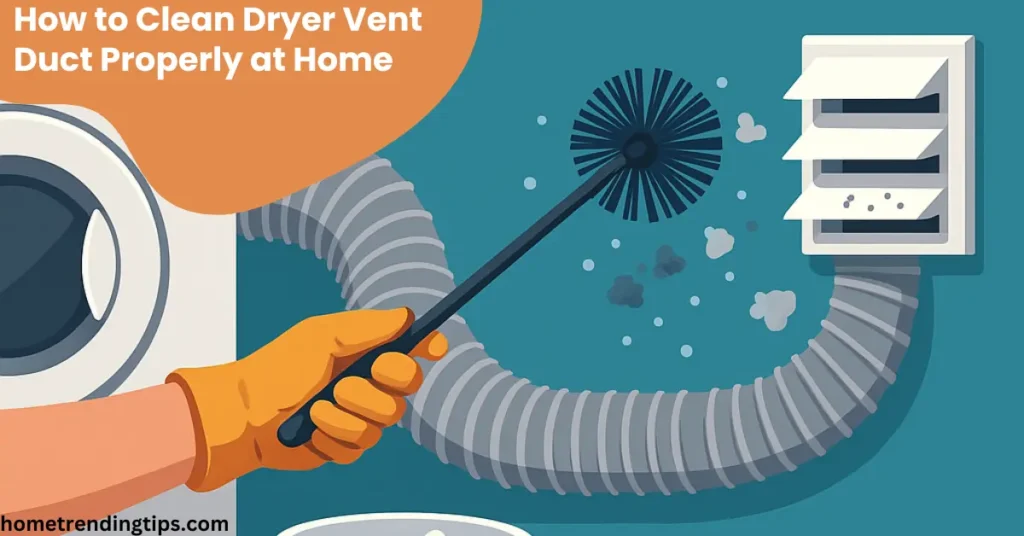Cleaning your dryer vent duct is one of the most crucial, yet commonly overlooked, household maintenance tasks. Neglecting it not only reduces your dryer’s efficiency but also poses a serious fire hazard. This article provides a complete guide on how to clean dryer vent duct effectively, along with safety tips, recommended tools, and maintenance practices to keep your laundry routine safe and efficient.
Why Dryer Vent Cleaning Matters
Over time, lint, dust, and fabric fibers accumulate in your dryer’s vent duct, clogging airflow. This buildup leads to extended drying times, higher electricity bills, and most importantly, increased fire risk. According to the U.S. Fire Administration, dryer-related fires account for nearly 3,000 home fires annually—many of which could be prevented by routine cleaning.
Beyond safety, cleaning your dryer vent ensures faster drying, improved air quality, and longer appliance lifespan.
Signs Your Dryer Vent Duct Needs Cleaning
If you’re unsure whether your dryer vent needs cleaning, look for these common signs:
- Clothes take longer than usual to dry
- Dryer feels unusually hot to the touch
- You smell a burning odor during use
- Visible lint around the dryer or exterior vent
- Damp laundry after a full cycle
- Dryer shuts off mid-cycle
These symptoms suggest restricted airflow, and it’s time to clean the vent.
How Often Should You Clean a Dryer Vent Duct?
Most experts recommend cleaning your dryer vent duct at least once a year, or more often for households that do frequent laundry. Also, clean the lint trap after every load and check the external vent quarterly.
Tools You’ll Need to Clean a Dryer Vent Duct Properly

Before you begin cleaning your dryer vent duct, it’s essential to gather the right tools. Having the correct equipment not only ensures a thorough job but also keeps you safe and helps prevent damage to your appliance. Below is a breakdown of the must-have tools and why each one is important:
1. Dryer Vent Cleaning Brush or Dryer Vent Cleaning Kit
This is your primary tool for dislodging lint and debris from inside the vent duct. A vent brush is typically long and flexible, designed to reach deep into the ductwork and scrub away the buildup. Many cleaning kits come with extension rods, rotary brushes, or drill attachments to make cleaning long ducts quicker and more effective.
2. Vacuum Cleaner with Hose or Crevice Attachment
Once the lint is loosened, a vacuum with a long hose or crevice attachment helps extract the debris from hard-to-reach areas. It’s particularly useful for sucking up lint from inside the dryer, vent pipe, and the exterior duct opening. A shop vac is even better for extra suction power.
3. Screwdriver (Flathead or Phillips)
You’ll need a screwdriver to detach any clamps, brackets, or screws holding the vent hose in place at the back of the dryer. The type of screwdriver required will depend on your specific dryer model—some use flathead screws, while others use Phillips head screws.
4. Bucket with Warm Soapy Water
A simple yet essential tool for cleaning the exterior vent cover. Soapy water helps break down stuck-on dirt, dust, or mildew. After removing the cover, soak or scrub it to restore proper airflow and prevent mold buildup. A gentle detergent works best to avoid damaging the vent material.
5. Safety Gloves and Face Mask
Dryer vents accumulate fine lint, dust, and allergens that can irritate your skin and respiratory system. Wearing durable work gloves will protect your hands from sharp metal edges inside the vent, while a mask shields your lungs from inhaling airborne particles during the cleaning process.
How to Clean Dryer Vent Duct: Step-by-Step Instructions
Cleaning your dryer vent duct is essential for safety, efficiency, and better drying performance. Follow these easy, step-by-step instructions to get the job done right.
Step 1: Disconnect Power and Gas Supply

Always unplug the dryer from the electrical outlet before starting. If you have a gas dryer, turn off the gas valve and cap it to prevent leaks.
Step 2: Locate and Disconnect the Vent

Move the dryer away from the wall—about one foot is usually enough. Identify the flexible metal duct connected to the dryer and loosen the clamps or tape securing it using a screwdriver.
Step 3: Vacuum Inside the Duct

Insert a vacuum hose or crevice wand into the duct opening at the back of the dryer. Carefully remove all visible lint and debris. If accessible, vacuum the wall outlet as well.
Step 4: Use a Dryer Vent Brush

Use a dryer vent brush to scrub the interior of the vent duct. These long brushes can reach deeper areas that vacuums can’t. If your vent is too long, consider a rotary brush kit for enhanced reach.
Step 5: Clean the Exterior Vent

Go outside and remove the cover from the exterior dryer vent. Clean the slats, inspect for rust, and remove any debris or lint using a brush and vacuum. Wash the vent cover in soapy water if needed and dry thoroughly before replacing.
Step 6: Reconnect and Test the Dryer

Reconnect the clean duct to the dryer and wall outlet. Ensure it’s sealed tightly using appropriate clamps or tape. Plug in the dryer or turn on the gas. Slide the dryer back in place and run a 10–15 minute cycle to clear out any remaining dust.
Additional Tips for Ongoing Maintenance
- Clean lint trap after every load. This simple habit drastically reduces lint buildup.
- Inspect the exterior vent quarterly. Make sure it opens freely and stays clean.
- Use a dryer vent brush kit once or twice a year for deep cleaning.
- Don’t use plastic or vinyl ducts. Opt for rigid or flexible metal ducts for safety.
- Avoid sharp objects when cleaning. They can damage the duct and increase fire risks.
Professional Dryer Vent Cleaning vs DIY
While DIY dryer vent cleaning is manageable, hiring a professional once every few years ensures a thorough job—especially if your duct is long or hard to access. Services like 1 Clean Air use high-pressure air tools, rotary brushes, and inspection cameras to eliminate every trace of lint safely.
Safety First: Important Precautions
- Always disconnect the power supply and gas line before starting.
- Wear gloves and a mask to protect against lint dust and allergens.
- Avoid abrasive materials or sharp tools that could damage your ducts.
- Replace damaged or torn vent ducts immediately.
- Reassemble everything securely and test before use.
FAQs About Dryer Vent Cleaning
1. How do I know if my dryer vent is clogged?
If clothes take longer to dry or you notice a burning smell, chances are your vent is clogged and needs immediate cleaning.
2. Can I clean my dryer vent duct from outside?
Yes, you can. Remove the exterior cover and use a brush or vacuum to remove debris. It’s most effective when paired with interior cleaning.
3. What tools are best for cleaning dryer vents?
A vacuum with hose attachments and a rotary dryer vent brush kit are the most efficient tools for thorough cleaning.
4. How long does dryer vent cleaning take?
Typically, it takes about 1–2 hours depending on duct length and how clogged it is.
5. Are ventless dryers better for small spaces?
Yes, ventless dryers don’t require external venting, making them ideal for apartments or homes with limited space.
Final Thoughts
Knowing how to clean dryer vent duct properly is a small task with huge benefits. From enhancing dryer efficiency to preventing home fires, this maintenance job should be a regular part of your household checklist. Whether you do it yourself or hire a professional, the key is consistency. Clean vents mean safer homes, cleaner clothes, and lower utility bills.
Disclaimer
Content on Home Trending Tips is for informational purposes only. Please consult professionals before making home or garden decisions.



